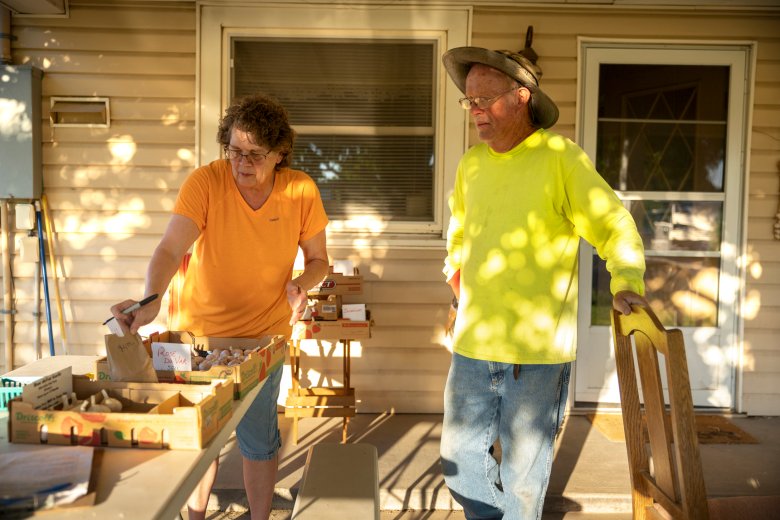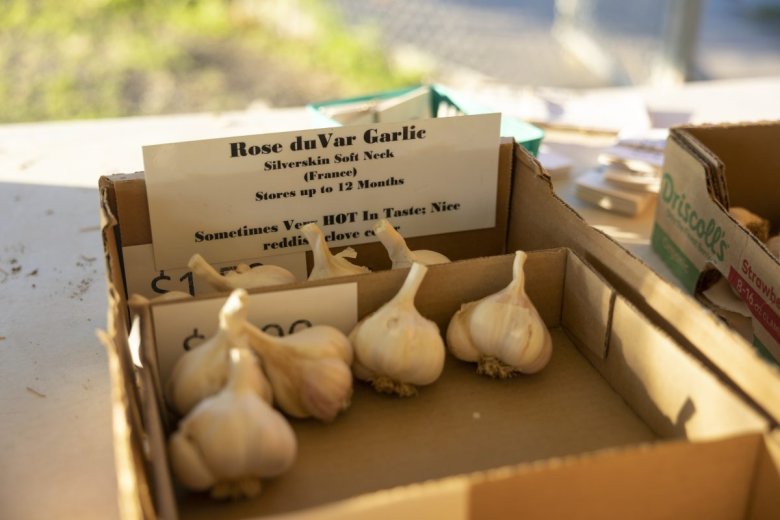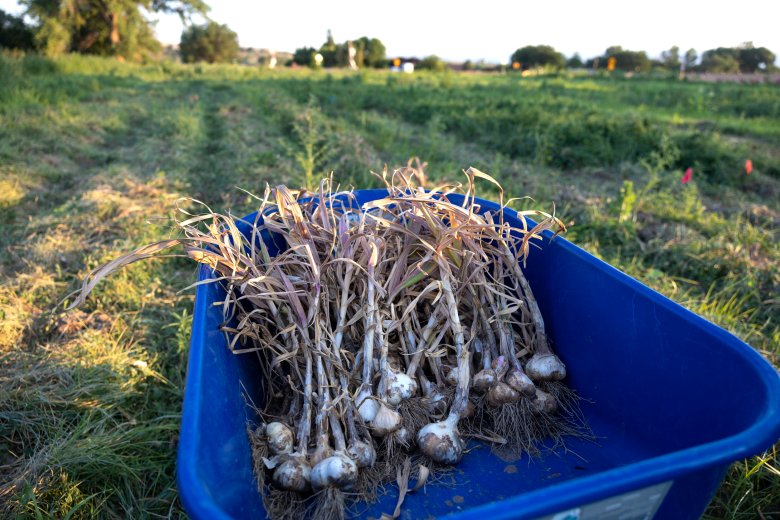Story first appeared in:
In a farmyard on the western outskirts of Palisade, a distinct odor seeps through the sweet scent of ripening peaches, the yeasty aroma of fermenting wine, and the perfume of lavender.
It doesn’t take a vampire to recognize that punchy smell. It is allium sativum — garlic — and it is wafting from the Green Acres U-Pick farm.
Green Acres U-Pick is the most prolific grower of garlic varieties in Colorado. In five acres that neighbor a handful of wineries, bulbs of Montana Zemo, Russian giant, Georgian crystal, Killarney red, rose de Lautrec and dozens of other garlic cultivars are waiting under the soil for farmer Bob Korver’s digging fork.
About 1,500 pounds of bulbs will be liberated within the next several weeks.
Bob and his wife, Elaine, still have fruits and vegetables dotting and fringing their small farm, but it is the half-acre spiked with the spear-like leaves of 40 garlic varieties that has bumped up the Korvers from garlic growers to garlic geeks.

If the Korvers were to put pins on a map showing where their garlic cultivars originated, the dots would be sprinkled to the far reaches of the world.
This year’s garlic crop originated in Siberia, the Republic of Georgia, the San Juan Islands, Uzbekistan, Russia, Italy, Spain, France, Transylvania, South Korea, Vietnam and Romania. There is also garlic that was first grown in California, New Mexico and the Colville Indian Reservation in Washington.
“I don’t think you will find anyone that is crazy as I am,” Bob admits about his garlic enthusiasm.
Elaine puts that obsession into more sensible terms: “We like to experiment.”
How to grow (and sell) garlic by hand
All the work of planting and harvesting garlic at Green Acres is done by hand except for the initial field preparation. Bob does that by putting around on his little orange Kubota tractor to create furrows.
Halloween is planting season. That’s when Bob hunkers down over those rows poking each garlic clove into the ground. For the next seven months, if all goes right, those single cloves will expand into a fist-sized bulb made up of many cloves.
Shortly after each Fourth of July, Bob starts the harvest by aiming his trusty garden fork with uncanny accuracy into the weed-choked rows. He digs and hauls in the early mornings and the evenings because the hot sun can leach some of the flavor from garlic.
He lays out the newborn allium bulbs in his well-used wheelbarrow and hauls them one load at a time up the road, past the revelers on the patio of Red Fox Cellars winery, to the Korvers’ little garlic-colored house.
There Elaine sorts it, with nothing more than an appraising eye and a quick heft in the hand to determine the size of each bulb.
In a couple of weeks, this same patio will become the sales floor for Green Acres garlic.

The Korvers don’t waste any time or money on advertising. Those in the know watch their Facebook page for Elaine’s posts that the garlic is ready or that different varieties are running out.
Right now, the Korvers’ earliest harvest is undergoing a two-week curing rest in their four-car garage (which has never had a car in it). They fill it with garlic four times each season.
Bob is responsible for nipping the leaves and stems from the rested bulbs before Elaine takes a cheapo toothbrush to them to banish clinging dirt. Bob helps out with that task, too, when he is waiting for dinner or hiding from the heat.
Last year, there was more scrubbing to do. The Korvers had 50 cultivars of garlic. A few of those didn’t do so well in the increasing heat of western Colorado.
Bob could easily have replaced those with some of the new allium cultivars he ogles in seed catalogues during the winter, but “she said enough,” he explains while cutting his eyes toward Elaine.
She levels a hard stare at him over a grin: “Enough is right!”
Trading the classroom for the field
The Korvers, both in their early 70s and married for 37 years, never saw garlic taking over their lives back in the day.
Bob moved with his third-generation agricultural family to a farm just down the road from Green Acres when he was 4 years old. He grew up picking peaches and trying to listen to his father who warned him: “If you want to make a million dollars in farming, start out with $2 million.”
He went off to the University of Northern Colorado in Greeley, then on to Colorado State University where he earned a master’s in guidance counseling. He taught English and journalism and coached volleyball and track as well as serving as a counselor at schools in Columbus, Nebraska, on the Eastern Plains of Colorado and eventually in Steamboat Springs.
Elaine first met Bob in Greeley where she was attending college to earn a degree in library science. She describes herself as a city girl. She had grown up in Omaha, Nebraska, and after college aspired to teach in larger places like Denver and later Grand Junction.

The two came together like garlic and bread when Elaine was doing a librarian stint in Rifle during the oil shale boom. Friends invited her along to watch a volleyball game in Steamboat.
In between games, she spotted a guy in the bleachers who was busy grading papers, oblivious to the hubbub around him. His briefcase was beside him. Bob!
Their conversation led to a connection and eventually to Green Acres after they both decided they would retire from their professions and farm together. They would grow fruits and vegetables without using pesticides and herbicides and showcase rows of lavender.

This story first appeared in
Colorado Sunday, a premium magazine newsletter for members.
Experience the best in Colorado news at a slower pace, with thoughtful articles, unique adventures and a reading list that’s a perfect fit for a Sunday morning.
They proved they could master lavender when their oils won two first-place prizes in an international lavender competition last year in Australia.
Neither one remembers exactly how they came to decide that the fragrant lines of waving lavender could be neighbors to a garlic plot. It has something to do with saving water. Garlic does not require much water.
Bob’s years of classroom planning made him well suited to garlic farming. Garlic is an easy thing to grow. Home gardeners can plunk cloves in loose soil and create a bulb. But the way Bob does it requires complicated charts and graphs and timing schedules. Locations, planting dates, size of cloves, names are all neatly printed out on papers spotted with sweat and dirt, and snapped onto a clipboard that resides in the garlic field while Bob is working there.
His colored charts correspond to brown, pink, blue, red, green, orange and yellow flags that flutter at the end of rows in the recent air-fryer heat.
“We wouldn’t want anyone to think they were getting one kind of garlic and get another,” Elaine explains about all that paperwork. She is, she admits, “the queen of handouts.”


LEFT: Bob Korver digs garlic from his half-acre garlic garden. RIGHT: Korver trims and cleans a recently harvested bulb. (Hugh Carey, The Colorado Sun)


TOP: Bob Korver digs garlic from his half-acre garlic garden. BOTTOM: Korver trims and cleans a recently harvested bulb. (Hugh Carey, The Colorado Sun)
Each garlic bulb sold or given away at Green Acres comes with one of Elaine’s cheat sheets of information about that particular cultivar. Elaine staples the info to the brown paper bags that she stresses are the only proper receptacles for storing garlic. Her slips include information on variety, taste, storage, cooking, how many cloves should be in one bulb, where the garlic originated and where the seed to grow it came from.
Elaine’s taste descriptions require a passel of adjectives, including mellow, complex, spicy, musky, hot, full-bodied and even explosive.
Beyond supermarket garlic
“I never knew there were that many varieties. It’s insane,” says Katie Henderson, a dedicated garlic customer at Green Acres who claims to cook with garlic every day. When she runs low on Green Acres garlic, she asks the Korvers to scrounge around for scraps. Even a couple of cloves will do, she says, to keep her from having to buy grocery store bulbs that she now writes off as bland.
Julie McSherry of Omaha waits every year at this time for a box of garlic from Green Acres.
“I get about 15 types. The variety is exceptional,” she says. “Pungent is a good word for it.”

Pungent is a good word for it.
— Julie McSherry, an Omaha resident who gets a yearly box of garlic from Green Acres
Jarrett Nelson says Green Acres garlic has become a favorite at the Gypsum Fire Protection District where he works with the Korvers’ son.
“I am not a garlic taste-tester expert, but I can definitely tell the difference,” he says of the many varieties he has tried and used in his firehouse meals of lasagna and carne asada. This year, he has found more recipes to showcase garlic. He also plans to roast it, store it in olive oil and turn it into a butter.
Sherrie and Scott Hamilton who own Red Fox Cellars say they also cook with it regularly. They welcome garlic wafting over to mingle with the top notes of cabernet franc and merlot at their winery.
“A lot of my customers see Bob out there working in his field and they ask us, ‘What is it that he’s doing?’” she says.
A crop with deep roots
If wine tasters wander over to talk to Bob, they can get a garlic lesson.
Garlic is one of the oldest crops tended by humans. It is believed to have evolved and spread from south central Asia and was carried around the Mediterranean and European continents by nomadic tribes.
Garlic appears in the oldest written language, Sanskrit, in writings from 5,000 years ago. The Egyptians used garlic with its loads of sulfides for food and medicine. They revered it so much they entombed garlic with their dead.
There are two subgroups of garlic — hardneck and softneck. The hardneck varieties send up a flower stalk that is known as a scape (a tasty morsel on the grill or in a pickle jar). Hardnecks do better in colder climates, and they often pack the spiciest punch.
Softneck garlic (the kind you will see in those fancy garlic braids) has no tough stem.

Beyond those neck differences, there are 13 sub-varieties of garlic. Bob holds up one called an artichoke. The name comes from the fact that the cloves resemble artichoke petals. The cloves on the outside are large, and they get smaller toward the center.
Bob has also grown sub-varieties of porcelains, purple stripes and creoles.
He didn’t do great with the latter, he says, because he failed to figure out that something called creole would do better in Southern climates.
“I’m kind of slow sometimes. I learn some things the hard way,” Bob says, garnering an indulgent smile from Elaine.
Garlic’s future
There are other vegetable farms around Colorado that grow garlic. The Rocky Mountain Garlic Farm near Salida grows about a quarter-acre on an agricultural operation that has gone in the opposite direction of Green Acres and pivoted to more vegetables. Several other small Colorado garlic farms have closed in recent years.
Trisha Nungester with Tagawa Gardens in Centennial says Tagawa sells about 40 varieties — mainly for seed. Their garlic comes from multiple sources, including the motherlode of U.S. garlic, Filaree Farms in Washington state. When Tagawa announces that garlic is ready for sale, there is always a line out the door with people clamoring for favorite varieties.
In terms of homegrown variety in Colorado, the Korvers take the odiferous prize.

They grouse about maybe wanting to plant less. They both have had health problems in recent years.
But their seed-saving practices say cutbacks won’t happen soon.
They are already at work picking out 300 pounds of the fattest bulbs that will be saved to seed next year’s crops.
And there is always one new garlic variety to try, one more wheelbarrow load to sort, one more giant bulb to marvel over, and one more group of kids who come to Green Acres to get a farming lesson from a librarian and a teacher who can’t drop those old habits.
Bob won’t tell many of them one of the deepest, darkest secrets of Green Acres: He really doesn’t like to eat garlic.


